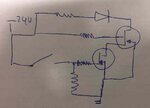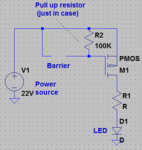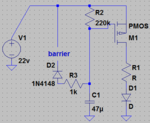mpiepen
Newbie level 2

Goodmorning,
I'm trying to light up a led with an old light barrier I still have around. I want the led to light up when someone passed the barrier. Unfortunately I have a 24v signal when the barrier is safe and when someone walks through it, the voltage drops to 0.
I still have some mosfets around but I’m not sure how to tackle this problem. I know I could use relay’s but I do not really have space for one. I have some mosfets and resistors so that shouldn’t be much of a problem.
Long story short: I’d like to make a 24v circuit with mosfets. When there is no signal my led should light up.
Is there a simple way to do it?
I'm trying to light up a led with an old light barrier I still have around. I want the led to light up when someone passed the barrier. Unfortunately I have a 24v signal when the barrier is safe and when someone walks through it, the voltage drops to 0.
I still have some mosfets around but I’m not sure how to tackle this problem. I know I could use relay’s but I do not really have space for one. I have some mosfets and resistors so that shouldn’t be much of a problem.
Long story short: I’d like to make a 24v circuit with mosfets. When there is no signal my led should light up.
Is there a simple way to do it?






